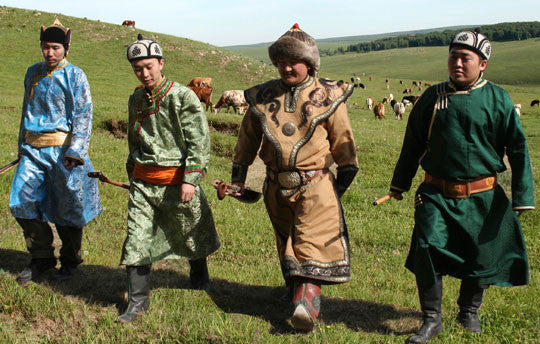Your Cart is Empty

Ethnic minorities are found all over China. In the 1950s the new communist government dispatched teams to record minority music and dance, providing pure research and raw material for professional song and dance troupes.
The Islamic ‘Uighurs’ from China’s far northwest Xinjian region are renowned for their music and dance traditions. Best known among these are the On ikki muqam; twelve classical song-and-dance suites. Instruments used include fiddles, plucked lutes (dutar, tanbur), dulcimer and the ass-hide drum (dap). Melodies are highly ornamented and generally built on a seven-note scale.
Another famous northwestern tradition is the Hua’er song, prevalent among groups in Gansu, Qinghai and Ningxia. The songs have a wide melodic range and are usually sung unaccompanied informally outdoors or at large festivals.
The Rough Guide To The Music Of China offers a snapshot of a myriad of Chinese music, each track displaying the emotions and attitudes of its own place in time and circumstance, from Cantonese opera to Beijing punk, from ancient traditions to revolutionary rock, from 1930s pop-swing to 1990s pop-folk.
Listen / Buy Now
In Sichuan, Guizhou, and Yunnan provinces, there are minority groups living in remote, mountainous areas, and still preserving traditional musical culture.
A recent discovery in Yunnan is the singing of rice-transplanting songs by the Hani people, in which men and women sing together; their voices entering successively to create a dense, microtonally coloured chordal effect.
Better known are the antiphonal courtship songs and enormous Lusheng (mouth organs) of the Miao of Guizhou.
Formed in Yunnan province of southwest China, Shanren, meaning ‘mountain people’, are becoming known for their eclectic style and promotion of Yunnan and Guizhou’s diverse heritage. The band use a mixture of original composition and re-workings of local folk melodies, alongside a variety of traditional instruments including the qinqin (plucked lute) and xianggu (drum).
 The mountains of south-western China have inspired the folk traditions of those living in their shadows for millennia. Now, Shanren follow their ancestors' footsteps with a mash of traditional Chinese folk and buzzing modernity on their infectious international debut Left Foot Dance Of the Yi.
The mountains of south-western China have inspired the folk traditions of those living in their shadows for millennia. Now, Shanren follow their ancestors' footsteps with a mash of traditional Chinese folk and buzzing modernity on their infectious international debut Left Foot Dance Of the Yi.
In the central south the Zhuang minority of Guangxi are known for their ‘song fairs’ at which young people get acquainted by singing love and question songs.
The Li of Hainan Island also have distinctive, though now declining musical traditions including a xylophone strung from a bamboo trestle or between trees, and the ‘pole’ dance in which girls rhythmically clap together bamboo poles while boys leap between.
The largest minorities in the far northeastern provinces are the Manchu and the Koreans. Many Korean customs and musical styles have been preserved; and some Manchu still practice traditional shamanistic rituals, where magic drums and waist-bells are used for communication with the gods.
Nearly five million Mongols live in China. Their music is rich in variety, and instruments include bowed and plucked strings, flutes, jew’s harp and percussion.
Hanggai are at the forefront of a musical movement in China that is finding inspiration in native folk traditions. Blending Mongolian folk music with more modern styles such as punk rock, the Beijing based band use primitive throat-singing techniques (hoomei) along with traditional instruments such as horse-hair fiddles (morin khuur) and strummed two-stringed lutes (tobshuur).
